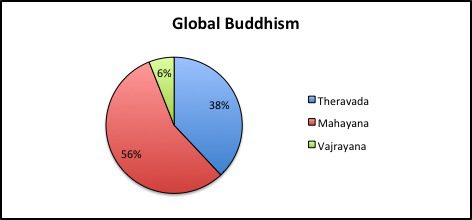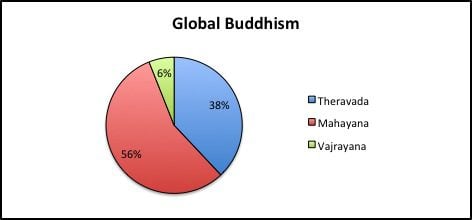The Buddhist world subdivides into three major branches: Theravada, Mayahana, and Vajrayana.
For reasons explained previously, estimates on the total world Buddhist population vary (by large margins). Some sources would put the total at well over a billion, but many more conservative estimates tend to be less than half that. One very conservative source estimates the actual number at around 330 million practicing Buddhists worldwide; other sources hover closer to 500 million.
Going with that very conservative — and quite possibly underestimated — grand total of 330 million, approximately 125 million (or about 38%) are Theravada Buddhists; at least another 185 million (56%) are Mahayana Buddhists (some estimates put the total number of Mahayanists far higher than that, which would significantly enlarge their percentage of the Buddhist pie); and another 20 million (6%) are Vajrayana Buddhists.
Theravada (“Way of the Elders”) Buddhism is the predominant form of Buddhism found throughout most of South and Southeast Asia. Sri Lanka, Burma (Myanmar), Laos, Cambodia, and Thailand are all Theravada-majority Buddhist countries.
Theravada thinks of itself as the oldest, purest form of Buddhism, the form most faithful to the original teachings of Gautama Buddha himself. It maintains that the path to nirvana is long and demanding, and that one must rely solely upon one’s own efforts to get there. No supernatural outside assistance can help you attain it; no magic words can automatically bestow nirvana, and no deity or enlightened spiritual being can simply tap you on the head and magically enlighten you. Rather, you must enlighten yourself, through rigorous spiritual discipline and the gradual development of spiritual insight; there are no shortcuts.
In the Theravada view, the surest and swiftest route up the mountain of enlightenment is a monastic life, modeled after the disciplined and meditative life of the Buddha himself. While it is not in principle impossible for ordinary average layfolk to attain nirvana, realistically and practically speaking their likelihood of success seems rather remote. Theravada societies are therefore highly respectful of monks and generously supportive of monasteries, while lay piety tends to focus upon accumulating sufficient good karma to eventually result in a future rebirth one day into life circumstances more conducive to entering into a monastic life, where one is at last free to focus completely upon one’s own diligent pursuit of nirvana (and free to do so on a full-time, 24/7 basis).
So that, in a nutshell, are the basics of what Theravada Buddhists believe and practice. But what about the other two major divisions of Buddhism — the Mayahana and Vajrayana branches? What do they believe in, and practice? How do they differ from Theravada, as well as from each other?
(To be continued — and concluded — in Part Four.)


